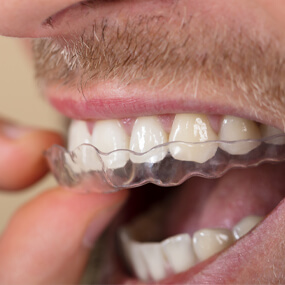Causes and Symptoms of Periodontal Disease and the Treatments

Periodontal disease is the technical term for what is commonly referred to as gum disease. It is an infection of the gums that causes them to become inflamed. The inflammation is characterized by redness, tenderness, swelling, and bleeding. The inflammatory response is a natural reaction by your immune system, but over time, it can cause deterioration of the soft tissue and, eventually, tooth loss.
What Is Periodontal Disease?
Periodontal disease is gum disease, which is among the most prevalent human diseases. In fact, the CDC estimates that more than half of American adults are afflicted. The disease is caused by periodontal bacteria that triggers localized inflammation. These bacteria are naturally occurring in the mouth, but poor oral hygiene and various health conditions can lead to higher-than-normal levels.
Gum disease is caused directly by plaque, which is a sticky substance formed by a reaction between bacteria and food particles. Plaque accumulates on teeth, between teeth, and along and beneath the gumline. It eventually hardens into tartar, which must be removed by your dentist. Plaque and tartar secrete acids that attack the teeth and cause cavities. The substances also cause the gums to be in constant contact with the bacteria that trigger the inflammatory response.
There are various stages of periodontal disease. Gingivitis is the earliest and most prevalent stage. It is reversible—often just through improved oral hygiene. Left unchecked, however, that gingivitis will evolve into periodontitis, which is more advanced and not reversible. Periodontitis can be halted and managed, but left untreated, it can lead to tooth loss and jaw deterioration. This is often a slow process that occurs over the years, but some people are affected by an accelerated version of the disease.
What Are the Signs of Periodontal Disease?
Gingivitis does not necessarily manifest symptoms right away. This can make it difficult to self-diagnose early on and why it is so important to see your dentist twice a year. When symptoms do manifest, which ones and how severe vary from person to person. You should be wary of increased sensitivity, redness, swelling, persistent bad breath, receding gums, and gums that bleed when you brush and floss.
Gingivitis can progress to periodontitis quite suddenly and without any special warning. Not only are smokers at greater risk, but they are often less inclined to notice the symptoms due to the effect nicotine has on blood vessels. Symptoms that can occur and worsen over time include halitosis, shifting teeth, apparent lengthening of the teeth, painful gums, and even spontaneous gum bleeding.
Among people who do not visit a dentist on a regular basis, it is not unusual for them not to notice gum disease until their 40s or even their 50s. By that time, a great deal of damage has already occurred. Dentists monitor their patients using a technique known as the Periodontal Screening Index, and so, people who see their dentist regularly often have their gum disease treated well before this stage.
What Causes Periodontal Disease?
Your mouth is an ecosystem with more than 700 distinct types of bacteria. Most of those bacteria are beneficial to the ecosystem. Some are not. In a healthy mouth, levels are kept low enough that the bad bacteria do not have a negative impact. Poor oral hygiene and various health conditions let that bad bacteria flourish, and it creates a nasty cycle in that your immune system becomes compromised.
All stages of periodontal disease are caused by plaque and tartar—which is also known as dental calculus. Brushing and flossing are imperative to remove plaque and to disrupt it so that it does not harden. Tartar is problematic not only because you cannot easily clean it yourself but because it promotes plaque formation deeper below the gumline. The attachment between the gum and tooth root becomes compromised, and periodontal pockets eventually form, which serve as an ideal harbor for bacteria and progress the disease even further and faster. This bacterial colony also further triggers an immune system reaction.
How fast periodontitis progresses and how severe the disease depends on various factors: bacteria count, risk factors, and the state of your immune system. The more aggressive the bacteria and weaker the immune system, the more destructive the disease. If a person has diabetes or smokes cigarettes, the progress of the disease can be further advanced. There are also various medicines and medical treatments that can make a person more prone to gum disease and its advancement. Be mindful, however, that without the plaque, gingivitis will never occur in the first place.
How Do You Prevent Periodontal Disease?
Gum disease is never unavoidable, and avoiding it is simply a matter of good oral hygiene. The American Dental Association recommends that you opt for a soft-bristled toothbrush and fluoride toothpaste with the ADA Seal of Acceptance. Brush for two minutes once after breakfast and again before bed. Be gentle, and take care to brush every side of each tooth. Whenever you brush, you should also brush your tongue or use a tongue scraper in order to remove the bacteria harbored there. You should also floss once a day using dental floss or an interdental brush.
Use dental floss wherever there is little to no space between the teeth. If you have gaps between certain teeth, you should use an interdental brush in those areas. Special care should be taken when cleaning around crooked teeth, crowded teeth, fillings, crowns, dentures, and other restorations.
It is also important that you visit a dentist every six months, and your dentist may recommend an even more frequent schedule temporarily or permanently if you have gum disease. A regular checkup usually involves a professional cleaning to eliminate any tartar. Your dentist or dental hygienist will also polish the teeth to create smoother surfaces less prone to plaque accumulation. You will get a fluoride rinse to bolster your teeth, and your dentist will perform a comprehensive examination of your mouth.
What Are the Consequences of Periodontitis?
The most obvious consequence of periodontitis is tooth loss. But the disease can also undermine the supporting tissues and bone. This can make you an unsuitable candidate for implants and other tooth-replacement options. During this process, gums can recede and expose the roots, teeth can drift to the point of a misaligned bite, and you can experience painful abscesses and other discomforts.
Consequences, however, can extend far beyond your mouth. Modern medicine now recognizes a deep connection between your gum health and your overall health. Gum disease poses additional risks during pregnancies, including premature birth, low birth weight, and infant gum disease. Gum disease exacerbates diabetes and has been linked to cardiovascular diseases, dementia, and more.
What Are the Gum Disease Risk Factors?
Stress is known as a risk factor not just for gum disease but general compromising of the immune system. Exercise and stress-management techniques are essential to limiting this impact. Diabetes makes you more prone to gum disease, and people with diabetes should work with their dentists to ensure that they avoid or manage the condition. Smoking is also a serious risk factor.
What Effect Does Smoking Have on Periodontitis?
Smokers are significantly more prone to gingivitis as well as significantly more prone to gingivitis advancing to periodontitis. Periodontal treatments, such as dental implants, gum grafts, and bone grafts, are less successful among smokers due to less ability to heal, and in some cases, the smoker is just ruled out as a candidate. Gum disease advances much more quickly in smokers, and in cases where patients do not respond to treatment, about 90 percent of those people are smokers.
How Does a Dentist Treat Gum Disease?
Although periodontitis is not reversible as gingivitis is, it can be halted. This requires all of the plaque and tartar removed and establishing an oral hygiene routine that prevents it from recurring.
- Oral hygiene recommendations—Oral hygiene is the first phase of any gum disease treatment because, without it, all other endeavors will be undermined. Your dentist will explain what caused your gum disease, where your efforts were coming up short, and how to proceed. It is important at this stage for a patient to be forthright and to work to make this advice a consistent everyday habit.
- Professional cleaning—Your dentist or dental hygienist will scrape away all tartar and remove plaque from all sides of the teeth, including beneath the gumline. The teeth will be polished to make it more difficult for plaque to accumulate, and a fluoride rinse will help bolster oral health. There may be additional cleaning required, including removing deposits from gingival pockets and root surfaces, and your dentist may schedule this additional cleaning sooner than six months.
- Antibiotic treatment—Your dentist may prescribe antibiotics in order to stop active or persistent infections of the gum. Sometimes, such recommendations require a microbiological evaluation, but in other cases, the dentist can make that decision without the need for that evaluation.
- Reevaluation—You will need to return to your dentist for a reassessment. This can be as soon as three weeks or even sooner if you have periodontitis. Your dentist will assess the inflammation, use a periodontal probe to measure pockets, and check for gum bleeding and other symptoms. If recovery is not progressing as hoped, the dentist may recommend surgery and other treatments.
- Corrective treatment—In some cases, a surgical procedure may be necessary to clean plaque from the periodontal pockets and the tooth roots. Since these areas are inaccessible via brushing and flossing, inflammation will persist until the bacteria is removed. Your dentist will give you anesthesia prior to lifting the gum away from the tooth so that the tooth root can be cleaned. In the event there has been bone loss, and regenerative treatment is possible, this can be performed at the same time. The dentist will conclude the procedure by suturing the gums back into place.
- Aftercare—Once gingivitis is reversed, good oral hygiene is enough to avoid a recurrence. In the event of periodontitis, you require ongoing assessment and management by your dentist in addition to good oral hygiene. The regularity of aftercare visits will depend on the severity of the disease. With periodontitis, it is not unusual for a dentist to recommend a visit every three months.
- Regular checkups—If all goes well, you will eventually move beyond aftercare to regular checkups. These checkups are important to keep your teeth cleaned and ensure your oral hygiene is going well. If you have periodontitis, your dentist will be able to identify recurrences in the earliest stages and therefore treat them before they advance into much more serious conditions.
Protect Your Gums
Your gums are vital not just to your oral health but your overall health. You can avoid gum disease with good oral hygiene and by seeing your dentist at least twice a year. If you’re looking for a periodontist near you, the good thing is that experienced Scottsdale dentists can help. If you are experiencing issues with your gums, then you should schedule an appointment at Scottsdale Cosmetic Dentistry Excellence. Jeffrey D. Clark, DDS, is a leading dentist in the Scottsdale area who can assess your oral health, advise treatment, and even refer you to a periodontist if the gum disease is severe. Reach us today by calling 480 585 1853.




